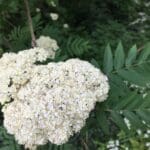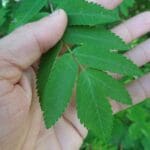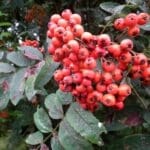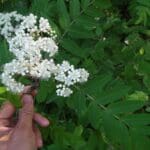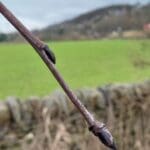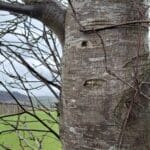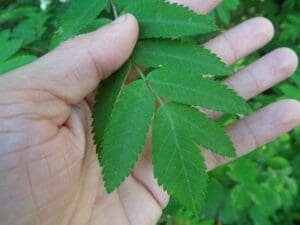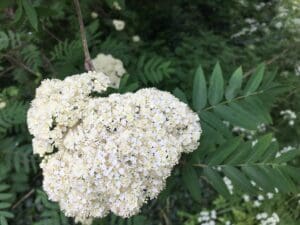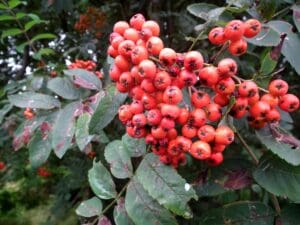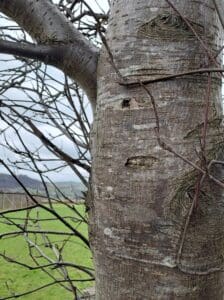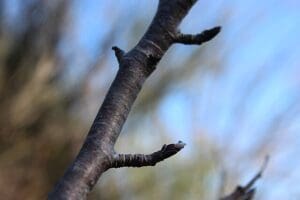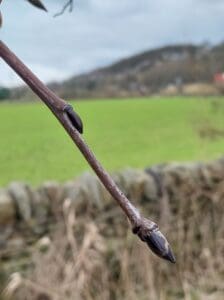Rowan / Spring /Summer /Autumn / Edible
Common Names
Rowan, Mountain Ash, witch wiggin tree, keirn, cuirn
Botanical Name
Sorbus aucuparia
Scientific Classification
Kingdom – Plantae
Order –Rosales
Family – Rosaceae
Physical Characteristics for Rowan
It occurs as a tree or shrub that grows up to between 5 and 15 m in height. The crown is loose and roundish or irregularly shaped but wide and the plant often grows multiple trunks. A trunk is slender and cylindrical and reaches up to 40 cm in diameter, and the branches stick out and are slanted upwards. Mature trees can live for up to 200 years.
Leaves
The compound leaves are pinnate with 4 to 9 pairs of leaflets on either side of a terete central vein and with a terminal leaflet. There are paired leaf-like stipules at the base of the petiole. The leaves are up to 20 cm long, 8 to 12 cm wide, and arranged in an alternate leaf pattern on a branch. The leaflets are elongated-lanceolate in shape, 2 to 6 cm long, and 1 to 2.5 cm wide with a sharply serrated edge, and have short stems or sit close to the central vein except for the outermost leaflet. Leaflets are covered in gray-silvery hairs after sprouting but become mostly bare after they unfold. Their uppers side is dark green and their underside is a grayish green and felted. Young leaflets smell like marzipan when brayed. The leaflets are asymmetrical at the bottom. S. aucuparia foliage grows in May and turns yellow in autumn.
Flowers
The plant flowers from May to June (on occasion again in September) in many yellowish-white corymbs that contain about 250 flowers. The corymbs are large, upright, and bulging. The flowers are between 8 and 10 mm in diameter and have five small, yellowish-green, and triangular sepals that are covered in hairs or bare. The five-round or oval petals are yellowish-white and the flower has up to 25 stamens.
Fruit
Its fruit is round pomes between 8 and 10 mm in diameter that ripen from August to October. The fruit is green before they ripen and then typically turn from orange or scarlet in color. The sepals persist as a black, five-pointed star on the ripe fruit. A corymb carries 80 to 100 pomes. A pome contains a star-shaped ovary with two to five locules each containing one or two flat, narrow, and pointed reddish seeds. The flesh of the fruit contains carotenoids, citric acid, malic acid, parasorbic acid, pectin, provitamin A, sorbitol, tannin, and vitamin C. The seeds contain glycoside.
Bark
Silvery and very smooth other than horizontal bands of lenticels. Bark typically dulls in colour and sheen in older trees, but is rarely rugged.
Twigs
Shoots green and hairy at first. Twigs grey, hairless and shiny.
Buds
Quite dull and unimpressive dark grey, sometimes with a tinge of purple. Covered in greyish-white hairs. Often longer than 1 cm. The hairs, which disappear over time, cover dark brown to black bud scales. The terminal buds are oval and pointed and larger than axillary buds, which are narrow, oval and pointed, close to the twig, and often curved towards it.
Habitat
Native to cooler regions of the northern hemisphere, most of Europe, parts of Asia and Northern Africa, and most common in the UK in the north and west, it often grows in high altitude locations.
It is commonly found in the wild, particularly in the highlands of Scotland, but it is also widely planted as a street or garden tree.
Known Hazards
Large quantities of raw fruit can cause vomiting, especially if people are not used to the fruit. Seeds probably contain hydrogen cyanide. this is the ingredient that gives almonds their characteristic flavour. Unless the seed is very bitter it should be perfectly safe in reasonable quantities. In small quantities, hydrogen cyanide has been shown to stimulate respiration and improve digestion, it is also claimed to be of benefit in the treatment of cancer. In excess, however, it can cause respiratory failure and even death.
Could be Confused with
Ash (Fraxinus excelsior) or Elder (Sambucus nigra), however, the leaflets are serrated and more or less pointed at the end in rowan than both of these.
Identified in winter by the young twigs start hairy and become smooth later. Buds are hairy all over. Terminal buds (on the ends of shoots) are up to 8mm in length and lateral buds (in leaf axils) have 2-5 scales.
Edible Uses
Rowan berries are edible to humans – they are really very sour but rich in vitamin C, and can be used to make a jelly to accompany meats. They can be debittered and made into compote, jelly, jam, a tangy syrup, a tart chutney, or juice, as well as wine and liqueur, or used for tea. Debittering can be accomplished by freezing, cooking, or drying, which degrades the parasorbic acid.
The fruit is very acid and large quantities of the raw fruit can cause stomach upsets. The fruit can also be dried and used as flour mixed with cereals.
The leaves and flowers are used as a tea substitute. Young leaves are said to be a famine food but they contain a cyanogenic glycoside so you should be very hungry before even thinking of eating them.
The fruit ripens from August to September. It is said that a frost reduces their bitterness, however, by the first frost, a lot of the fruit will have perished. Much better to collect earlier and freeze at home.
Notes on Herbal uses
Antirheumatic; Antiscorbutic; Aperient; Astringent; Diuretic; Hypoglycaemic; Laxative; Vitamin C.
In folk medicine, they are used as a laxative, against rheumatism and kidney disease, and as a gargled juice against hoarseness. Fruit is eaten as a mash in small amounts against lack of appetite or an upset stomach and stimulates the production of gastric acid.
The bark is astringent, it is used in the treatment of diarrhea and as a vaginal injection for leucorrhoea, etc.
The fruit is antiscorbutic and astringent. It is normally used as a jam or an infusion to treat diarrhea and hemorrhoids. An infusion can also be used as a gargle for sore throats and as a wash to treat hemorrhoids and excessive vaginal discharge.
The seeds contain cyanogenic glycosides which, in reaction with water, produce extremely toxic prussic acid. In small quantities, this acts as a stimulant to the respiratory system but in larger doses can cause respiratory failure and death. It is, therefore, best to remove the seeds when using the fruit medicinally or as a food.
Both the flowers and the fruit are aperient, mildly diuretic, laxative and emmenagogue. An infusion is used in the treatment of painful menstruation, constipation and kidney disorders.
Extra notes from the Foragers
Rowan was once widely planted by houses as a protection against witches. The colour red was considered to be the best colour for fighting evil, and so the rowan, with its bright red berries, has long been associated with magic and witches. Its old Celtic name is ‘fid na ndruad’, which means wizards’ tree. In Ireland, it was planted near houses to protect them against spirits, and in Wales rowan trees were planted in churchyards. Cutting down a rowan was considered taboo in Scotland.
The wood was used for stirring the milk to prevent it from curdling, and as a pocket charm against rheumatism. It was also used to make divining rods.
The wood is pale yellow-brown with a deeper brown heartwood. It is strong, hard and tough, but not particularly durable. It is sometimes used in turnery, furniture, craftwork and engraving.
The leaves are eaten by caterpillars of a number of moths, including the larger Welsh wave and autumn green carpet. Caterpillars of the apple fruit moth feed on the berries.
Flowers provide pollen and nectar for bees and other pollinating insects, while the berries are a rich source of autumn food for birds, especially the blackbird, mistle thrush, redstart, redwing, song thrush, fieldfare, and waxwing.
In the past, the fruit was used to trap birds. Usually harvested in October. The leaves were fermented with leaves of sweet gale and oak bark to create herb beer.



